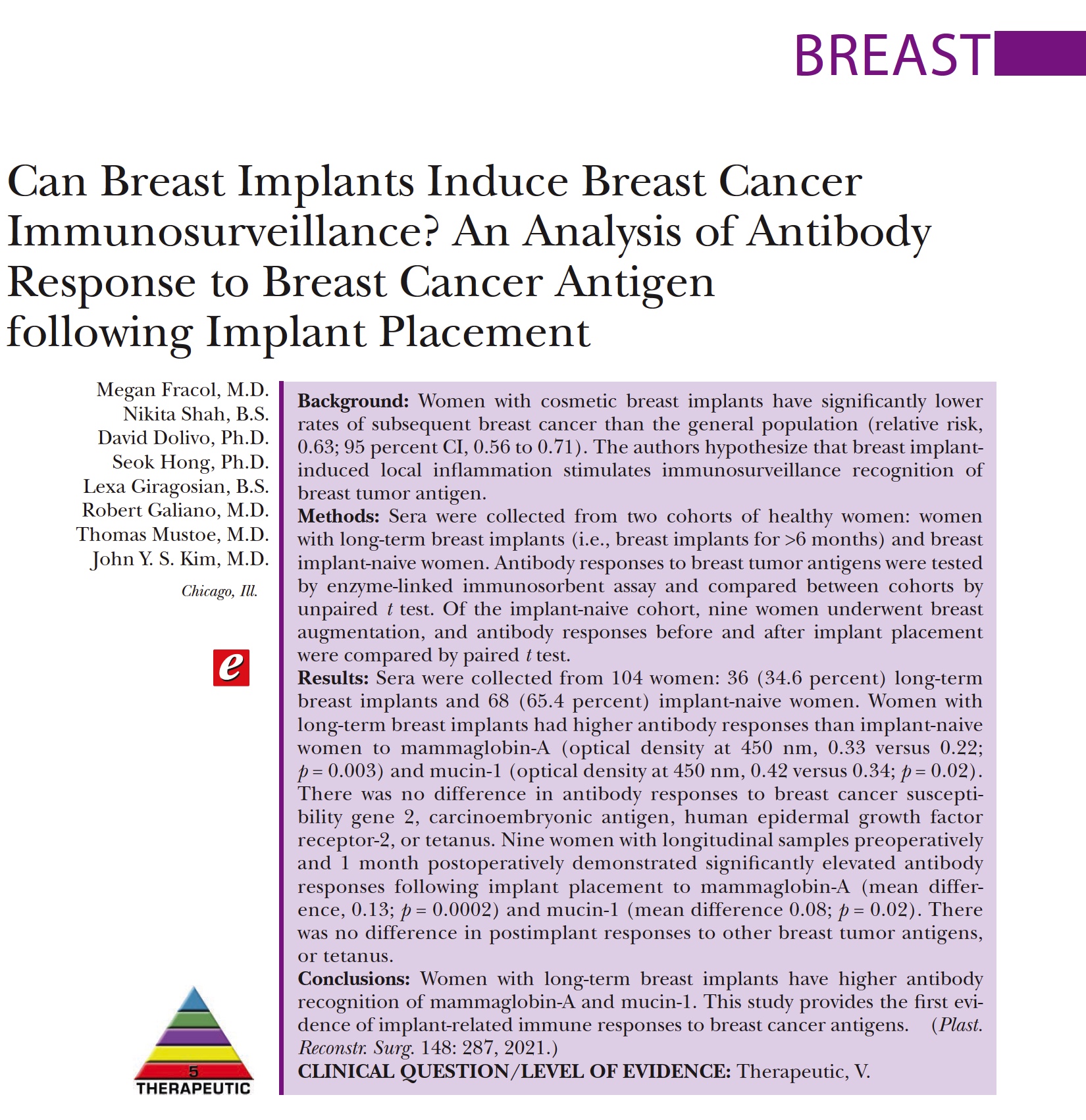ARTICLES
Breast Implants and Breast Cancer
Many patients considering breast implants are understandably concerned about the possibility of breast cancer in the future. There is no doubt that the incidence of breast cancer is on the rise, with current estimates of 1 in 7 lifetime risk in Western populations (1). Many of these patients also have breast implants in place, hence we need to ask whether breast implants can somehow lead or predispose to breast cancer. To help us understand a potential link, some recent studies have produced particularly interesting data which, when considered together suggest positive news. I will go through the main points in a step-by-step approach below and apologise upfront that some of the terminology is necessarily complicated. Because of the sensitivity of these issues, I have also included the scientific references at the bottom of the page to support my interpretation, and provide further reading for those interested.
Breast implants do not increase the chances of breast cancer
We have known for many years that patients who have cosmetic breast implants in place have a very small reduced chance of developing breast cancer (2). It was thought that this finding was an anomaly due to population bias. What this means is that if you decided to have breast implants then you were usually more athletic with smaller breasts and more health-conscious overall. These factors could mean that you are less likely to develop breast cancer than the normal population. Hence this group of patients had a reduced chance of developing breast cancer, but this was not a direct effect of the implants themselves.
Could there be a direct effect from breast implants to reduce the chances of developing breast cancer?
In some animal studies, it appears that the presence of silicone may reduce the development of breast cancer (3). It’s difficult to draw conclusions from this in human populations and also difficult to understand how such an effect could come about. Theories have included a physical pressure effect of the implant on the breast tissue or the fact that the breast tissue is pushed forward away from the body, which might have a slight cooling effect on the cells. With a greater understanding of the relationship between the immune system and cancer development, it has more recently been theorised that antibodies (one part of the body’s immune response to fighting off unwanted substances) generated in response to the implant could cross-over and also work against certain types of breast cancer.
We now understand that cells within the body transform into potential cancer-causing cells more often than previously thought. Our immune systems watch out for these transformations and kill off the cells before they become dangerous. This is known as immunological surveillance or ‘immunosurveillance’. A study from Chicago published in 2021 (4), showed that patients with breast implants had an elevated level of serum antibodies against two breast cancer antigens (Mammaglobin-A and mucin-1). The hypothesis from this study is that breast implant-induced local inflammation may stimulate immunosurveillance recognition of breast tumour antigen.
This means that a specific immune response to silicone breast implants could also act to fight off some cancer cells and limit the development of breast cancer. There was no significant difference in overall antibody levels in the study groups, so the implants don’t appear to be stimulating the entire immune system. However, in patients with a breast implant in place, specific antibodies that act against some breast cancer antigens were elevated. This is only a hypothesis at the moment and certainly not proven but it may begin to explain the observed reduction in breast cancer in patients with silicone breast implants.

Does the data from breast cancer reconstruction help with our understanding?
Some surgeons and oncologists have recommended caution with breast reconstruction following the treatment of breast cancer, as they feel additional surgery could lead to an increased chance of local recurrence (the breast cancer coming back at the site of the previously treated tumour). It has been difficult to prove or disprove this supposition because there are so many variable factors involved in the treatment of breast cancer. These factors include the extent of the disease at the time of treatment, the treatment modalities such as radiotherapy and chemotherapy, and the fact that breast reconstruction can consist of fat grafting, tissue transfer from elsewhere on the body or silicone breast implants. However, it is now generally accepted that breast cancer reconstruction with implants is not directly linked to breast cancer recurrence (5).
Looking into the data in more detail, one study from Korea in 2020 linked textured surface implants to an increased chance of breast cancer recurrence (6). This caused significant alarm amongst breast reconstructive surgeons, however the design of the study was widely criticised as the cancer types between those patients with and without breast implants were not closely matched. A more recent and rigorous study (7), again from Korea, with 848 patients and greater matching showed breast cancer recurrence was categorically not affected by breast implant surface type.
Hence, although we continue to monitor new data, the current data strongly suggests that breast implants (textured or smooth) when used in breast cancer reconstruction do not change the chances of the cancer returning.

Can breast implants delay the diagnosis of breast cancer?
Some individual small studies have suggested that the presence of a breast implant may delay the detection of a breast cancer. However, larger grouped studies have not shown this (8). In many cases, the implant allows a lump to be felt more easily, partly because patients with breast implants have heightened awareness, and also because lumps close to the breast implant can more easily be detected by being pushed forward towards the skin surface. Modern imaging techniques with computerised mammography also mean that the implants are not an obstruction to assessing the entire breast. Hence, it is clear that the presence of breast implants does not delay the detection of a breast cancer.
Even though research indicates that breast cancer in women with implants is not diagnosed at a later stage compared with women without implants, it is important that all women participate in a routine program of breast cancer detection, including both breast self-examination and mammography. In addition, women with implants should undergo mammography with standard compression views plus additional modified views to allow better imaging of the breast. We are also entering an era of increased implant surveillance, and patients in my practice are now recommended to have an ultrasound check of their implants every three years through a linked service called Implant Health.
What about BIA-ALCL and other rare cancers?
It has become clear in recent years that a type of white blood cell cancer can develop in the capsule scar tissue that surrounds aggressively textured implants. This is known as Breast Implant Associated-Anaplastic Large Cell Lymphoma (BIA-ALCL). Numbers vary in the literature but it would appear that the chances of developing this are around 1 in 2,500 breast implants inserted if the textured implants are from a company called Allergan (9). These implants have now been taken off the market and the link to the remaining less aggressively textured implants is significantly lower. Although this link may still cause concern for patients, there are some advantages to texturing on the surface of many implants. These advantages include a potentially reduced rate of capsular contracture and greater implant position control. Thus, a decision on whether to use textured implants is individualised and something that you should discuss with your specialised plastic surgeon.
BIA-ALCL is not a classic breast cancer (from breast tissue) and recent developments in treatment mean that this type of cancer is curable for most patients. Such treatment usually only involves surgery. Hence, the risk to patients has been determined to be so low that regulatory authorities have not mandated that Allergan implants be removed. Again, if you have concern then you should seek advice from a plastic surgeon who specialises in this area of surgery.
There are also other cancers linked to breast implants that are exceptionally rare. In particular, there is a cancer called Implant Associated-Squamous Cell Carcinoma (IA-SCC). This is a cancer that also appears to emanate from the breast implant capsule and is not considered a true breast cancer. A total of 30 cases have been reported over the last 30 years across all types of implants. It is important to recognise that these 30 cancers have occurred in close to 10 million patients with breast implants (in 2011, the US Food and Drug Administration estimated that there are 5 to 10 million breast implant recipients worldwide (10)), and that more than 60 cases of very similar dental implant associated cancers (11) have also been reported, which puts these numbers into perspective.
Summary
As you can see from the data above, this is a very complicated area of study and therefore difficult to draw absolute conclusions. What we can say is that silicone breast implants do not increase the chances of breast cancer, and indeed they may lead to a reduction in breast cancer on a population basis. A possible immune-system link to explain this effect has been theorised. However, we don’t fully understand the immune response to breast implants because in some patients with very aggressively textured implants, the inflammatory stimulation can lead to different rare cancers of the immune system.
The great majority of patients who undergo breast implant surgery do not experience any serious complications, although it is important to be fully informed. If you are considering breast implants, or if you have breast implants in place and have concerns, then it is important to see a specialised plastic surgeon who understands the latest data available and can advise you on your own individualised risk before you move forward with surgery.
References
- Cancer Research UK
- Breast implants and the risk of breast cancer: a meta-analysis of cohort studies. Noels EC, et al. Aesthetic Surg J 2015. Jan:35(1):55-62. PMID: 25568234
- Silicone implants and the inhibition of cancer. Su CW, et al. Plast Reconstr Surg 1995. 96(3):513-518. PMID: 7638276
- Can breast implants induce breast cancer immunosurveillance? An analysis of antibody response to breast cancer antigen following implant placement. Fracol N, et al. Plast Reconstr Surg 2021. 148(2):287-298. PMID:
- Breast cancer recurrence after reconstruction: know thine enemy. Brett EA, et al. Oncotarget 2018. 9(45):27895-27906. PMID:
- Association of implant surface texture used in reconstruction with breast cancer recurrence. Lee KT, et al. JAMA Surg 2020. 1;155(12):1132-1140. PMID: 7542523
- Impact of implant surface type on breast cancer relapse after breast reconstruction: a propensity score-matched study. Ha JH, et al. British Journal of Surgery 2023. :1-5. PMID: 37307506
- Breast implants and cancer: causation, delayed detection, and survival. Hoshaw SJ, et al. Plast Reconstr Surg 2001. 107(2):1393-1408. PMID:
- M. Clemens. 3rd International BIA-ALCL Consensus Conference, Rome November 2021
- FDA Update on Safety of Silicone Gel Filled Breast Implants
- Clinical retrospective analysis of peri-implant oral malignancies. Seo MH, et al. Int J Implant Dent 2024. Feb 6;10(1):5. PMID: 38321262